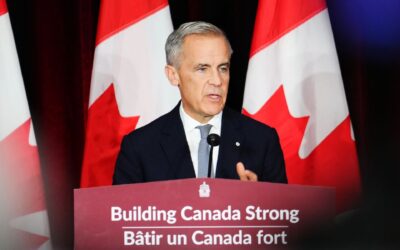Capturing and storing carbon emissions could play a big role in achieving Canada’s climate targets. In particular, carbon capture and storage (CCS) could help reduce emissions in challenging sectors, provide a path to blue hydrogen production, and even support efforts to remove carbon dioxide from the atmosphere (“negative emissions”). The opportunities are clearest in Western Canada, which has both the geology and the know-how to implement it.
In its recent budget, the federal government committed to funding a tax credit for CCS as a way both to reduce greenhouse gas emissions and galvanize investment in a struggling sector, paralleling policy in the United States. Win-win, right?
As usual, policy trade-offs are a little more complicated. There is a case for additional policy to support CCS. But how policy is implemented matters, especially in terms of minimizing costs. Ultimately, this is a policy question that extends well beyond CCS. As the federal government reaches toward even-deeper emissions reductions by 2030, it will require more, or more stringent, policies. The most cost-effective policies will be those that make sense as a complement to carbon pricing.
Taking a “Q” from the U.S.
A big part of the reason that an investment tax credit is on the table in Canada is because of the American Section 45Q tax credit, which is helping to drum up investment in CCS in that country. 45Q is a performance-based tax credit. Companies with projects of a sufficient scale get a monetary benefit for the CO2 they sequester – US$35/tonne for geological storage in support of enhanced oil recovery (EOR) and US$50/tonne for non-EOR storage. (The Canadian tax credit intends to exclude the use of CCS in EOR but many other details are still to be determined.)
The 45Q credit makes sense in the U.S. because the country does not have a carbon price. Without carbon pricing, there is little financial incentive to take on large and capital-intensive CCS projects. 45Q helps close that gap. It also corresponds with a broader approach that the U.S. relies on much more than Canada does – production and investment credits are a common way that federal and state governments support renewable energy development, for example.
But Canada does have a broad-based and rising carbon price that can provide the incentives that the U.S. lacks. So, the question is: do we need policy that supports CCS in addition to that price? If so, what kind?
Supporting carbon pricing
A 2017 report from Canada’s Ecofiscal Commission called Supporting Carbon Pricing (which, full disclosure, I worked on) provides a useful framework for thinking about this question. It argues that one key reason to bring in incentives beyond carbon pricing is if market or policy problems inhibit the carbon price from providing the incentives it otherwise would.
There are three key market and policy failures at play in the context of CCS, which point the way to what effective corresponding government intervention could look like:
1. Gaps in the carbon pricing system: When the level of the future price on carbon – or even whether there will be a carbon price – is uncertain, businesses and households may hold off on making greenhouse gas-reducing purchases and investments, which can ultimately raise the cost of greenhouse gas reductions. This is clearly the case for CCS, where the capital requirements are steep and where the business case for the investment depends on carbon prices increasing significantly.
Solution: Close the gaps. The fix for uncertainty around future carbon prices is an obvious one –make them more certain. This is easier said than done, but in this context, consensus may be closer than it appears. While consumer carbon pricing remains politically divisive, both federal and provincial governments have enacted output-based pricing – the version that applies to large industrial emitters – and the approach is also supported by opposition parties. The main source of uncertainty in output-based pricing systems is how high future prices will go. But that can be resolved today. If Alberta and Saskatchewan were to commit to the federal government’s planned rise to $170/tonne by 2030 (and if the federal Conservative Party were to strengthen its commitment to this path), it would give big emitters the stable policy signal for which they’ve been asking, and would help drive uptake of CCS. And in the interim, there may also be other clever solutions for addressing uncertainty.
Astute readers might point out that design issues within output-based pricing systems could still create challenges. There may not be demand for the credits that CCS projects could produce if system benchmarks are set too loosely and don’t tighten over time. This would undermine incentives for CCS adoption. But even a generous investment tax credit will drive limited uptake of CCS if these systems are too weak. So the best way to fix these gaps – if they exist – is to close them by tightening stringency, rather than using investment tax credits as a band-aid.
Other aspects of output-based pricing systems might also warrant a closer look as well. For example, they do not currently incentivize negative emissions – a critical application of CCS technologies that will be an important part of efforts to stabilize the global climate.
2. Knowledge spillovers: When one company’s knowledge spills over, it can benefit other companies and that can perversely discourage companies from investing in costly innovations that will bring shared benefits. This market failure certainly applies to CCS, which is notoriously complex and where greater experience will be critical to scaling it up.
Solution: Fund innovation. Governments can (and do) help address knowledge spillovers by funding research, development and demonstration (RD&D). Supporting innovation rather than deployment provides greater knowledge spillovers. Support for demonstration projects is particularly important for CCS, because it helps make the investments for first movers less risky, provides valuable lessons on which others can draw and shows the more-reluctant adopters what the current state of technological readiness is. The recent federal budget pledged $319 million over seven years toward RD&D for CCS. We can debate the total amount of support and how it will be targeted, but this support certainly will go a long way toward addressing this key market failure.
3. Network externalities: New technologies that use a network can come with a chicken-and-egg market failure. Users are reluctant to adopt the technology because they’re not sure the network can meet their needs (think electric vehicles and range anxiety). The private sector is reluctant to build out that network until it’s sure demand will be there. This chicken-and-egg problem applies to CCS. Work from the Boston Consulting Group has made it clear that CCS will be most economical and effective when it’s built in networked regional hubs.
Solution: Invest in shared infrastructure. For electric vehicles, the solution is for governments to take a role in building the charging network. The same can be done for CCS. The pipelines that transport the captured CO2 and the facilities that sequester it can be constructed at governments’ expense. There is then a much stronger incentive to adopt capture technologies, because companies wouldn’t have to also worry about the required transport and sequestration infrastructure. This shared infrastructure can be as much as 20 per cent of the costs of doing CCS. It can also be the most difficult to co-ordinate because it requires multiple players coming together.
Building this infrastructure would be an investment. It gives governments an asset that generates returns. Like the electric vehicle-charging network, governments would charge fees for its use. These user fees, coupled with the fact that the infrastructure is likely to remain in use over the long term (it can support sequestration of industrial emissions, blue hydrogen production, or negative emissions), could help governments attract private investment. Indeed, CCS infrastructure may be ideally suited to development as a public-private partnership under the Canada Infrastructure Bank. In time, the asset could be sold off to the private sector. Conversely, it could be retained by government as a revenue-generating asset.
Why an investment tax credit overshoots the mark
All of the above market and policy failures can be addressed more directly and cost effectively by improvements to carbon pricing, RD&D and public construction of infrastructure than they can through an investment tax credit. If used in combination, these interventions would strongly incentivize CCS while also making investment in the technology less risky.
A tax credit would certainly help further support development and deployment of CCS, but at what cost? Any meaningful level of support would have significant fiscal costs because the government would end up bankrolling much of industry’s deployment of CCS. To the extent that an investment tax credit would benefit the oil and gas sector, it could also undermine Canada’s commitment to phase out inefficient fossil-fuel subsidies.
The distortions that the tax incentive create would also impose additional costs. A CCS-specific tax credit tilts the playing field in favour of CCS. In doing so, it makes investment in other safe bets like energy efficiency, electrification and renewable fuels more expensive in relative terms. Where companies rely on them less as a result, it reduces our opportunities to scale and build experience with them, and raises the overall cost of meeting Canada’s greenhouse gas targets.
Some might still argue that an investment tax credit is necessary because Canadian industry is too emissions-intensive and trade-exposed to be able to decarbonize without public support. But other policies already address this. Output-based pricing is specifically designed to reduce emissions while protecting competitiveness. The Net Zero Accelerator fund – which the recent budget topped up to $8 billion – is available to help industry with the cost of greenhouse gas-reducing investments.
Making it work
Canada has the potential to be a key player in CCS. The International CCS Knowledge Centre believes Canada has unique advantages to build on, and that the sector could be an economic boon to the nation. Not only could CCS help Canada meet its own emissions goals as well as create economic opportunities, it could also make an important contribution to the global effort to stabilize the climate.
We should seek to provide Canadian industrial sectors and CCS with the support they deserve, but Canada can and should make that policy support as cost-effective as possible.
Given that a tax credit is likely to go ahead at this point, a few design tweaks could help. The federal government could, for example, make the credit refundable, to ensure that startups can benefit as much as large incumbents (which are more likely to have existing tax burdens). Even more importantly, the size of the credit should be calibrated so that it leverages private investment, rather than substitutes for it. It should be only as generous as necessary to motivate companies to invest their own money.
The bigger challenge
The stakes here are much bigger than they appear. Canada has recently upped the ambition of its 2030 target, so we will now need to close the gap with new policies. The government has wisely put carbon pricing at the centre of its greenhouse gas-reduction efforts so far. But given that is has signaled it will use other policies to close the gap, ensuring that those policies truly complement the carbon price is critical. That means carefully identifying where and why carbon pricing falls short and tailoring additional policies to tackle those problems in a targeted way. This particularly applies to what we use the uncertainty around future carbon prices to justify. If we’re not careful, we could end up with costly spending that duplicates much of what would have occurred anyway.
This is a warning that matters in particular in a rapidly changing North American context. Canada should be incredibly careful about taking cues from the U.S. The Biden government is likely to continue to put spending at the centre of its climate plans because carbon pricing is unlikely to get past Congress and because regulations take time to implement and can be reversed. Thankfully, Canada is bringing a wider array of tools to bear. But that also means that American-inspired climate policies won’t always translate well to Canada.
Originally published by Policy Options.
Beth (Hardy) Valiaho from the International CCS Knowledge Centre and Ilana Hosios and Keith Halliday from Boston Consulting Group contributed to this article.








